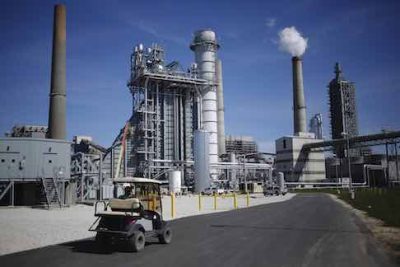In the race to Net Zero, the construction of the world’s largest carbon capture facility in Texas exposes all the contradictions of the energy industry in one emblematic project.
The importance of the Petra Nova plant cannot be overstated. By burying the CO2, its backers believe they can eliminate the biggest single criticism of fossil fuel consumption. Bloomberg breathlessly reported it would sequester “1.4 million tonnes” of carbon per year. This sounds like a lot, and The Guardian report says “The plant will inject 500,000 tons of carbon dioxide into the ground each year.” Whichever, its success would be a proof of concept for the fossil fuel industry. Hundreds more plants would follow, say the owners, JX Nippon. But a careful look at their figures shows their claims just do not add up.
Positioned as a crucial solution to avert climate catastrophe (if it actually works) the “$1bn” facility aims to capture and store carbon dioxide emissions from a nearby coal-fired power plant. Petra Nova began operating in 2016 at the power plant in Texas, and shut down less than four years later after a fire (and following a plunge in oil prices during COVID-19). It restarted on Sept. 5, JX Nippon said last month.
The W.A. Parish Generating Station is a 3.65-gigawatt (3,653 MW), dual-fired power plant located near Thompsons, Texas. The station occupies a 4,664-acre site and consists of two four-unit plants; one natural gas and the other coal (2,697 MW). With a total installed capacity of 3,653 MW, it is the second largest conventional power station in the US, and supplies about fifteen percent of the energy in the Houston area. Critics argue it was initially responsible for the rolling blackouts of the 2021 Texas power crisis.
As mentioned above, and reported in breathless tones by Bloomberg, the carbon capture plant claims it can bury 1.4 million tonnes a year – but the coal-fired power station emits over 16 million tonnes per year, (assuming it is operating at 70% capacity). And the Gas-fired plant would emit another 3 million tonnes (at 70% capacity). So the claims of 1.4 million tonnes of CO2 per year, which Reuters reports as a target but Bloomberg report as an actuality, is less than 10% of total emissions from the power plant. It would require another $9 billion of investment just to sequester all the CO2 from this plant alone.
With some viewing carbon capture as nothing more than a distraction backed by the fossil fuel industry, the above analysis shows the maths of the Petra Nova project just dont add up. If it wasnt for the government subsidies the plant would not make anything like enough to pay for itself, and produce a return on investment.
So if the Petra Nova project really is a huge white elephant, then what is it all about really? Why would some of the sharpest business managers in America be ploughing a cool billion dollars into the scrubland of East Texas?
the answer is all too predictable. Petra Nova appears to be a gigantic Ponzi scheme to shuffle carbon tax dollars back to the energy industry whose problems it is claiming to solve.
Its backers are hoping to turn a profit from the sale of carbon credits – the new industry that shuffles around government subsidies and is paid for out of general taxation. Perhaps the most damiing statistic is that earlier this year, JX Nippon paid just $3.5m to for the 50% of the stock they didn’t already hold, yet the US government has already awarded it $190m in grants via the Department of Energy.
The seller was NRG Energy- whose shareholders include Vanguard Group Inc, BlackRock Inc., State Street Corp, Putnam Investments Llc, PEYAX , Permian Investment Partners and many others. JX Nippon is owned by Japanese metals giant Eneos Holdings. Clearly they have little faith in the project if they were able to sell half of it for such a paltry sum. At off-grid.net, we think they made the correct. decision.
The price of carbon credits ranges from as low as $6 to as high as $50 per metric tonne—depending on the market, the type of credit, and other variables. Using a moderate estimate of $20 per metric tonne for this calculation: 19,300,000 metric tonnes * $20/metric tonne = $386m per year.
At $20 per metric tonne, the carbon credits for sequestering 19.3 million tonnes of CO2 could be worth approximately $386 million. But only if the system is rigged to hand that money – Our money– to the plant operators.
Furthermore, the new carbon capture plant is only capable of handling a tiny percentage of the actual carbon emitted from the power plant. So the actual return on the $1bn investment, according to JX Nippon’s own figures is an estimated $28m.
An annual return of 2.8% on capital employed does not even cover inflation – never mind the interest of 4% the money could garner, just sitting in the bank.
The world’s largest carbon capture facility promised to revolutionize our approach to tackling climate change. Yes, it presented a glimmer of hope in an increasingly dire situation. The ceremonial groundbreaking event sent ripples of optimism through the climate community. But careful examination shows the business case is based on a mirage.
If this is the case then carbon capture is nothing more than a clever ploy by the fossil fuel industry to continue their polluting ways while masquerading as environmental stewards. By investing in carbon capture, the industry can maintain its hold on the market while delaying transitioning to cleaner energy sources.
Amidst the skepticism, breakthroughs in direct air capture technology cannot be overlooked. The recent funding injection from the Biden administration partially validates the potential of this technology.
Direct air capture holds the promise of not just reducing current emissions but also addressing the legacy emissions that continue to haunt our planet. However, the magnitude of carbon removal required far exceeds the current efforts.
VERDICT: Carbon capture plants like this one are just Green-washing. JX Nippon deserves to be prosecuted for fraud.
Notes on our calculations about the amount of CO2 emitted from WA Parish power station in Texas
CO2 emissions from the coal fired section of the Parish plant
The amount of CO2 emitted annually from a coal-fired power station depends on a range of factors, including the type of coal used, the efficiency of the plant, and its capacity factor (the amount of time it actually operates during the year). For the purpose of providing a rough estimate, let’s assume:
- The power plant operates at a 70% capacity factor, a reasonable estimate for a coal-fired plant.
- The plant uses sub-bituminous coal, a common type, which emits approximately 2,130 lbs of CO2 per MWh, according to the U.S. Environmental Protection Agency.
Here’s how we calculate the annual CO2 emissions:
- Calculate the annual energy production: 2,697MW?0.70(capacityfactor)?24hours/day?365days/year=16,559,292MWh/year
- Calculate the CO2 emissions: 16,559,292MWh/year?2,130lbsCO2/MWh=35,291,812,360lbsCO2/year
- Convert to metric tonnes (1 metric tonne = 2204.62 lbs): 35,291,812,360lbs/year/2204.62lbs/metrictonne=16,011,873metrictonnesCO2/year
CO2 emissions from the gas fired section of the Parish plant
The CO2 emissions from a gas-fired power station depend on multiple factors including the type of gas being used (usually natural gas), the efficiency of the turbines, and the capacity factor of the plant (i.e., the percentage of time the plant is actually operating). For the sake of this estimation, we make a few assumptions:
- The plant uses natural gas.
- The capacity factor is about 70%, which is a reasonable average for many gas-fired plants.
- According to the U.S. Environmental Protection Agency (EPA), the emission factor for natural gas is about 1,135 lbs of CO2 per MWh.
Here’s how we calculate the annual CO2 emissions:
Calculate the annual energy production
990MW?0.70(capacityfactor)?24hours/day?365days/year=6,084,780MWh/year
- Calculate the CO2 emissions:
6,084,780MWh/year?1,135lbsCO2/MWh=6,906,225,300lbsCO2/year - Convert to metric tonnes (1 metric tonne = 2204.62 lbs):
6,906,225,300lbs/year/2204.62lbs/metrictonne=3,132,663metrictonnesCO2/year
Auto Amazon Links: No products found.

















